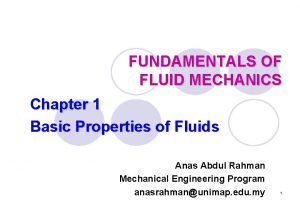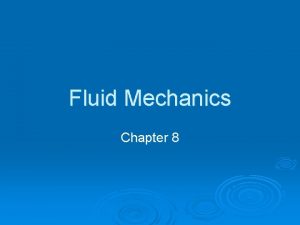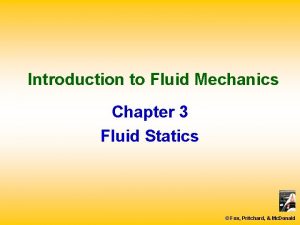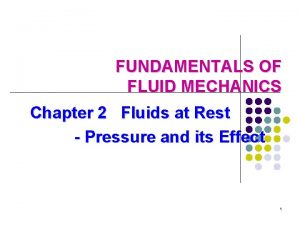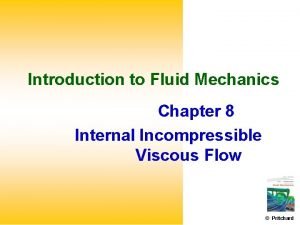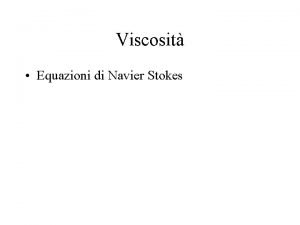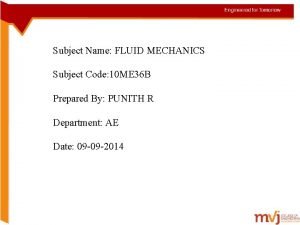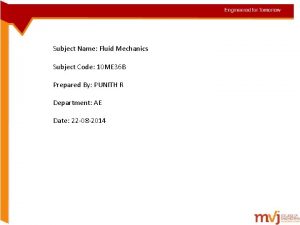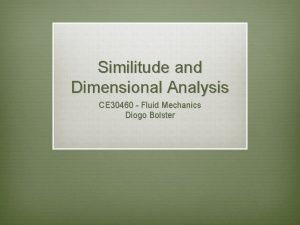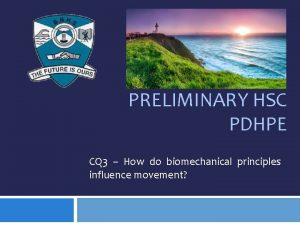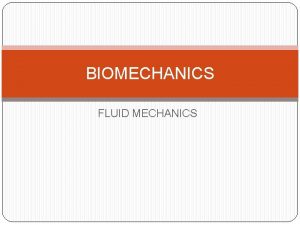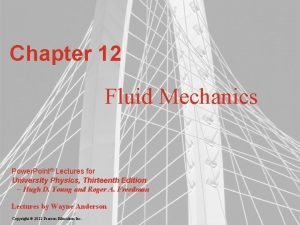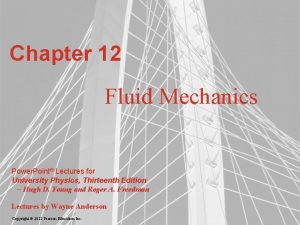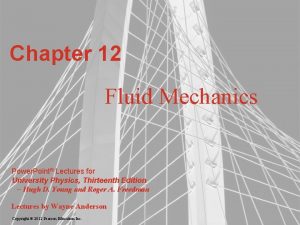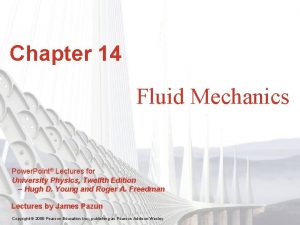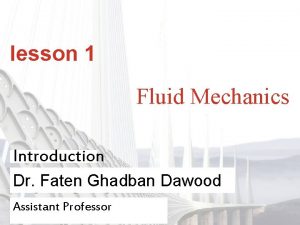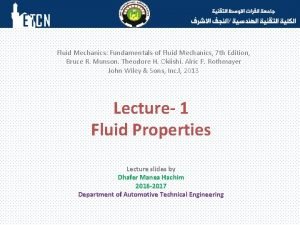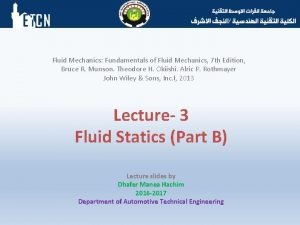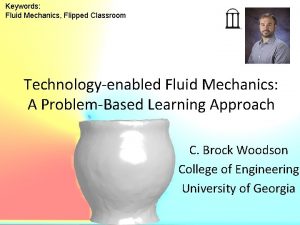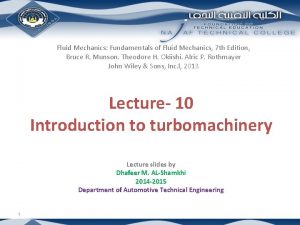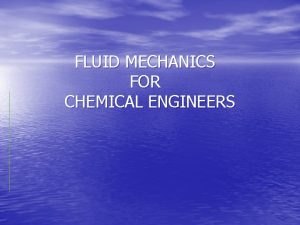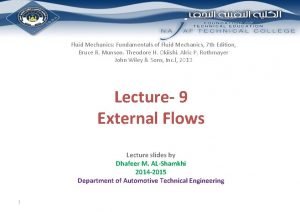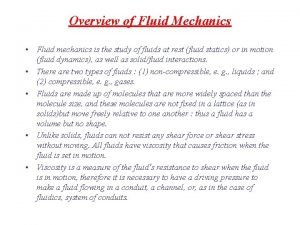Chapter 14 Fluid Mechanics Power Point Lectures for





















- Slides: 21

Chapter 14 Fluid Mechanics Power. Point® Lectures for University Physics, Twelfth Edition – Hugh D. Young and Roger A. Freedman Lectures by James Pazun Copyright © 2008 Pearson Education Inc. , publishing as Pearson Addison-Wesley

Goals for Chapter 14 • Pressure, depth, and Pascal’s Law • Buoyancy and Archimedes Principle • Surface tension • Bernoulli’s equation Copyright © 2008 Pearson Education Inc. , publishing as Pearson Addison-Wesley

Densities of common substances—Table 14. 1 Copyright © 2008 Pearson Education Inc. , publishing as Pearson Addison-Wesley

The pressure in a fluid • Pressure in a fluid is force per unit area. The Pascal is the given SI unit for pressure. • Estimate the force act on a paper due to air pressure of 1 atm? • Estimate thickness of atmosphere. Compare your result with data. Copyright © 2008 Pearson Education Inc. , publishing as Pearson Addison-Wesley

Pressure, depth, and Pascal’s Law • Pressure is everywhere equal in a uniform fluid of equal depth. • What happen if the pressure is not everywhere equal? Copyright © 2008 Pearson Education Inc. , publishing as Pearson Addison-Wesley

Buoyancy and Archimedes Principle • The buoyant force is equal to the weight of the displaced fluid. • Why? Copyright © 2008 Pearson Education Inc. , publishing as Pearson Addison-Wesley

Surface tension • How is it that water striders can walk on water (although they are more dense than the water)? Copyright © 2008 Pearson Education Inc. , publishing as Pearson Addison-Wesley

Copyright © 2008 Pearson Education Inc. , publishing as Pearson Addison-Wesley

Capillarity Vertical Force Capillary pressure Capillary rise Copyright © 2008 Pearson Education Inc. , publishing as Pearson Addison-Wesley

Q: How high could the water been transport in a plant through capillary rise? Typical diameter is about 20 micrometer The calculated height is about 74 cm What happen to plant higher than 74 cm? Copyright © 2008 Pearson Education Inc. , publishing as Pearson Addison-Wesley

Pressure in spherical bubble Energy required for area increasing Work done by pressure Copyright © 2008 Pearson Education Inc. , publishing as Pearson Addison-Wesley

Fluid flow I • The flow lines at left are laminar. • The flow at the right is turbulent. Copyright © 2008 Pearson Education Inc. , publishing as Pearson Addison-Wesley

Fluid flow II • The incompressibility of fluids allows calculations to be made even as pipes change. • The continuity equation Copyright © 2008 Pearson Education Inc. , publishing as Pearson Addison-Wesley

A stream of water emerging from a faucet, the initial cross-section area is known to be 1 cm 2. When the level of water stream drop 5 cm, the stream cross-section is found to reduce to 0. 4 cm 2. What is the flow rate from the tap? A. 20 B. D. 60 B. 35 C. 50 E. 70 Copyright © 2008 Pearson Education Inc. , publishing as Pearson Addison-Wesley cm 3/s

Introduction • Submerging bath toys and watching them pop back up to the surface is an experience with Archimedes Principle. • Fish move through water with little effort and their motion is smooth. Consider the shark at right … it must keep moving for its gills to operate properly. Copyright © 2008 Pearson Education Inc. , publishing as Pearson Addison-Wesley

Bernoulli’s equation • Bernoulli’s equation allows the user to consider all variables that might be changing in an ideal fluid. Copyright © 2008 Pearson Education Inc. , publishing as Pearson Addison-Wesley

The Venturi meter (Bernoulli’s Equation IV) • Consider Example 14. 9. Copyright © 2008 Pearson Education Inc. , publishing as Pearson Addison-Wesley

Lift on an airplane wing • The first time I saw lift from a flowing fluid, a man was holding a Ping-Pong ball in a funnel while blowing out. A wonderful demonstration to go with the lift is by blowing across the top of a sheet of paper. • Refer to Conceptual Example 14. 10. Copyright © 2008 Pearson Education Inc. , publishing as Pearson Addison-Wesley

A curve ball (Bernoulli’s equation applied to sports) • Bernoulli’s equation allows us to explain why a curve ball would curve, and why a slider turns downward. • Consider Figure 14. 31. Copyright © 2008 Pearson Education Inc. , publishing as Pearson Addison-Wesley

A 5 meter height, 2 meter radius water tank is filled up with water. If at the bottom of the tank is been drilled with a 1 cm diameter small hole, please estimate the speed of water exiting the tank. A. 1 m/s B. D. 10 m/s B. 3 m/s E. 14 m/s Copyright © 2008 Pearson Education Inc. , publishing as Pearson Addison-Wesley C. 7 m/s

Danger of Tailing By closely following another car, one can reduce the air drag for saving energy. However, the disrupted air flow will eliminate the negative lift effect on the rear car. This is danger in the case of car racing. If the tailing car does notify this effect, it might slip out during a turn. H. W. Estimate the negative lifting force on a car with a speed of 100 Km/hr. Copyright © 2008 Pearson Education Inc. , publishing as Pearson Addison-Wesley
 Timeline fluid mechanics
Timeline fluid mechanics Power system lectures
Power system lectures Dynamic viscosity symbol
Dynamic viscosity symbol Chapter 8 fluid mechanics
Chapter 8 fluid mechanics Fluid mechanics chapter 3
Fluid mechanics chapter 3 Datum line in fluid mechanics
Datum line in fluid mechanics Fluid mechanics chapter 8 solutions
Fluid mechanics chapter 8 solutions Synovial membrane
Synovial membrane P1-p2
P1-p2 Fluid statics deals with
Fluid statics deals with Transcellular fluid
Transcellular fluid Ecf icf and interstitial fluid
Ecf icf and interstitial fluid Interstitial vs intracellular
Interstitial vs intracellular Extracellular fluid and interstitial fluid
Extracellular fluid and interstitial fluid Amount of fluid for fluid thrill
Amount of fluid for fluid thrill Equazioni navier stokes
Equazioni navier stokes Loss of head due to sudden contraction of pipe *
Loss of head due to sudden contraction of pipe * Total head equation
Total head equation Dimensional analysis fluid mechanics
Dimensional analysis fluid mechanics Laminar flow reynolds number
Laminar flow reynolds number Fluid mechanics pdhpe
Fluid mechanics pdhpe Dimensionless numbers in fluid mechanics
Dimensionless numbers in fluid mechanics


